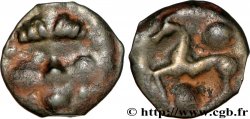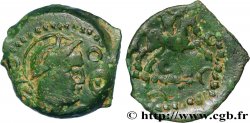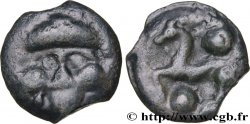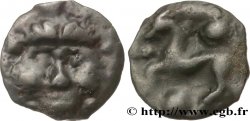bga_346034 - GALLIA - BELGICA - PARIS AREA Fibule monétiforme
Not available.
Item sold on our e-shop (2015)
Price : 390.00 €
Item sold on our e-shop (2015)
Price : 390.00 €
Type : Fibule monétiforme
Date: c. IV-IXe siècles après J.-C.
Metal : bronze
Diameter : 23,5 mm
Weight : 4,01 g.
Rarity : R3
Coments on the condition:
Objet avec un avers complet et bien identifiable. Revers sans l’ardillon. Belle patine verte, un peu hétérogène par endroits
Catalogue references :
Obverse
Obverse legend : ANÉPIGRAPHE.
Obverse description : Tête nue à droite, la chevelure en mèches raides tirées en arrière ; grènetis et bourrelet périphérique.
Reverse
Reverse description : Traces de l’ardillon.
Commentary
Cet objet n’est probablement pas d’origine gauloise, mais il a bel et bien sa place dans cette boutique.
Réalisé plusieurs siècles après que les monnaies gauloises aient cessé de circuler en Gaule, cette fibule s’inspire d’un potin gaulois !
Le prototype n’est pas le potin dit “à la cigarette”, comme nous l’avions proposé dans MONNAIES XV (n° 1063) mais plus vraisemblablement le “Potin au cheval”, classe III (LT. 7859).
Les deux trous sont vraisemblablement des traces de suspension, marquant une réutilisation postérieure.
Des objets techniquement comparables auraient été découverts dans des sépultures de l'époque mérovingienne. Les monnaies gauloises se retrouvent couramment dans les tombes mérovingiennes. Cette parure pourrait très bien être le dessus d'une fibule, dont il manque l'ardillon, réalisée par un artisan (de l'époque gauloise à l'époque médiévale) séduit par l'iconographie du potin celtique dit “à la cigarette” qu'il aurait eu entre les mains.
This object is probably not of Gallic origin, but it definitely has its place in this shop. Made several centuries after Gallic coins had ceased to circulate in Gaul, this fibula is inspired by a Gallic potin! The prototype is not the so-called “cigarette potin,” as we proposed in COINS XV (no. 1063) but more likely the “Horse Potin,” class III (LT. 7859). The two holes are likely traces of suspension, indicating a later reuse. Technically comparable objects have been discovered in Merovingian-era burials. Gallic coins are commonly found in Merovingian tombs. This adornment could very well be the top of a fibula, from which the pin is missing, made by a craftsman (from the Gallic period to the medieval period) attracted by the iconography of the Celtic potin called “à la cigarette” which he would have had in his hands.
Réalisé plusieurs siècles après que les monnaies gauloises aient cessé de circuler en Gaule, cette fibule s’inspire d’un potin gaulois !
Le prototype n’est pas le potin dit “à la cigarette”, comme nous l’avions proposé dans MONNAIES XV (n° 1063) mais plus vraisemblablement le “Potin au cheval”, classe III (LT. 7859).
Les deux trous sont vraisemblablement des traces de suspension, marquant une réutilisation postérieure.
Des objets techniquement comparables auraient été découverts dans des sépultures de l'époque mérovingienne. Les monnaies gauloises se retrouvent couramment dans les tombes mérovingiennes. Cette parure pourrait très bien être le dessus d'une fibule, dont il manque l'ardillon, réalisée par un artisan (de l'époque gauloise à l'époque médiévale) séduit par l'iconographie du potin celtique dit “à la cigarette” qu'il aurait eu entre les mains.
This object is probably not of Gallic origin, but it definitely has its place in this shop. Made several centuries after Gallic coins had ceased to circulate in Gaul, this fibula is inspired by a Gallic potin! The prototype is not the so-called “cigarette potin,” as we proposed in COINS XV (no. 1063) but more likely the “Horse Potin,” class III (LT. 7859). The two holes are likely traces of suspension, indicating a later reuse. Technically comparable objects have been discovered in Merovingian-era burials. Gallic coins are commonly found in Merovingian tombs. This adornment could very well be the top of a fibula, from which the pin is missing, made by a craftsman (from the Gallic period to the medieval period) attracted by the iconography of the Celtic potin called “à la cigarette” which he would have had in his hands.







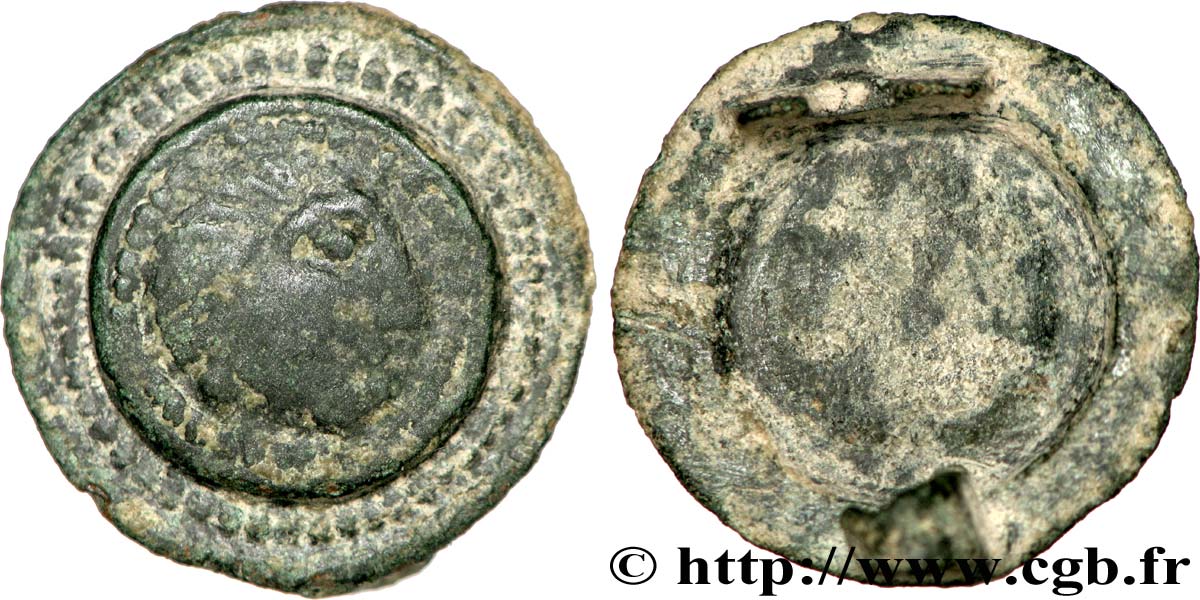
 Report a mistake
Report a mistake Print the page
Print the page Share my selection
Share my selection Ask a question
Ask a question Consign / sell
Consign / sell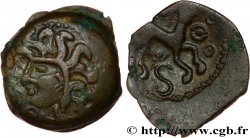
 Full data
Full data